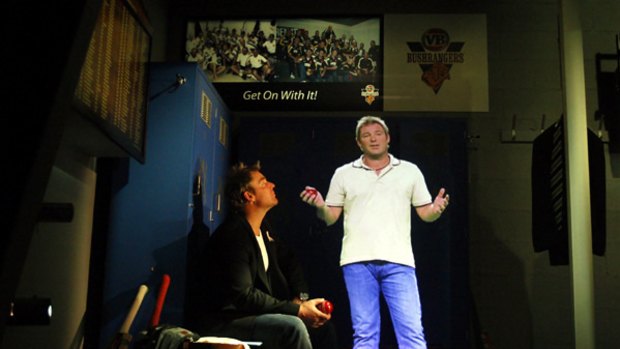
History comes alive ... Shane Warne watches himself in hologram form.Credit: Paul Rovere
There are those of us who know the Don's baggy green is not just a hat and that the months we wasted bar-chatting about the winged keel were, as they say, barely enough. There are no self-help books for an addiction to sport but there is a major fix in the National Sports Museum at the Melbourne Cricket Ground.
The museum turns one this month and is a must-see for those who go straight to the back page of the paper first.
A tour map and a digital audio player are included in the entry fee. There are 61 sporting stories available: whether your interest runs to basketball, the history of the Bledisloe Cup or Greg Norman's incredible run as golf's No.1, you can tune in and reminisce.
At The People's Ground exhibit, showcasing the history of the MCG - the sacred site of Aussie sport - you will learn that the biggest crowd ever pulled to the "G" was 130,000 in 1959 to the Billy Graham crusade. I can't remember who he played for but he must have been a champion. An old sign retrieved from the rubble of a demolished grandstand pays due reverence to Bay 13, the wild boys' section, where beer and abuse of Pommy cricketers flowed freely. It says: "Spectators stand here at their own risk."
At the Spirit of Sport display, you will find the Sport Australia Hall of Fame. Just behind Jack Brabham's Repco formula one racer, which claimed four grands prix in 1966, are potted interactive biographies of our "greats". Here you can compare the deeds of Heather McKay, Herb Elliot, Reg Gasnier, Makybe Diva and many more. The Hall of Fame Honour Roll makes you realise we are bloody good.
Cricket takes centre stage in the Backyard to Baggy Green exhibit. Stumps painted on rubbish bins and old pictures of children playing in alleys and streets lead to displays including old equipment, a replica Ashes urn, player biographies and statistics and even Dennis Lillee's aluminium bat (patent pending). You can see yourself on stump cam and be the third umpire for run-out decisions.
A lovely, cheesy 1950s video shows children playing on the road and nearly being hit by a car. Don Bradman gets out and gives them a lesson on road safety and the forward defence.
The adjoining Melbourne Cricket Club Museum is included in the tour price and provides a more austere veneration of flannelled foolery. Artworks, silverware, equipment and old records are featured in ornate wood-and-glass cabinets.
Warwick (the Big Ship) Armstrong's enormous shirt and 32-centimetre-long boots and the "Blackham ball" used to take the last few wickets when Australia beat England in England for the first time, in 1882, are just a couple of the hundreds of icons.
Bleak City's obsession with Australian rules football is apparent in the Australia's Game gallery. Premiership cups stand alongside a curious array of merchandise from eras past, including team toilet paper. Whether supporters bought rolls in their own team's colours or of a hated opposition team is unclear but Collingwood outsold the others.
Video highlights of famous high marks run alongside Footy Show lowlights of Sam Newman's antics. Even the umpires have a display, albeit in a small, dark corner.
The Multi-Sports exhibition covers basketball, golf, the rugby codes, soccer, cycling and boxing, among others.
Photos include Evonne Goolagong stretching for a forehand, exposing those frilly knickers of the '70s. Liz Ellis's recounting of Aussie netball triumphs brings a patriotic lump to the throat and the story of Paralympian Louise Sauvage is simply inspirational.
Game On is a fun, interactive gallery where you can try your hand at running out a batsman, cycling in a virtual velodrome and pushing in a rugby scrum.
I developed a new respect for archers as I tried to pull back a bowstring; the virtual goalkeeper was virtually impassable from the soccer penalty spot.
Athletics world records are displayed, including the 2.45-metre high-jump record. When you stand next to the mark on the wall, it just seems impossible.
Aussie Olympic achievements are showcased in the Faster, Higher, Stronger section. From the olive branch wreath awarded in 1896 to our first gold medallist, Edwin Flack, to the prawn on a bicycle from the Sydney 2000 closing ceremony, the Olympic display is crammed with memorabilia.
The 1956 Olympic flame cauldron is there, along with the evolution of the swimsuit and numerous photo and video highlights. I could watch Steven Bradbury win that speed-skating gold over and over ...
TRIP NOTES
See jetstar.com.au and virginblue.com.au for fares.
The National Sports Museum, inside Gate 3 at the Melbourne Cricket Ground, is open from 10am to 5pm daily (except during major events). Entry is $15 for adults and $8 for children. For more information, see nsm.org.au.
Sign up for the Traveller Deals newsletter
Get exclusive travel deals delivered straight to your inbox. Sign up now.